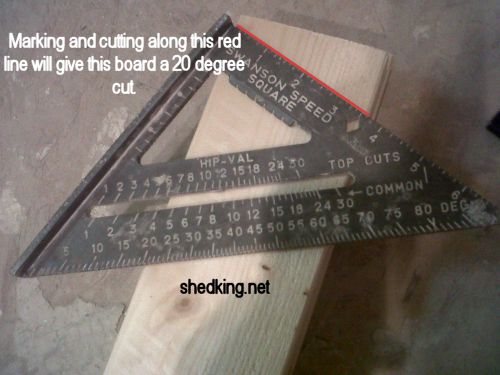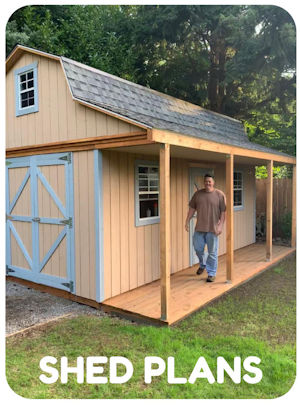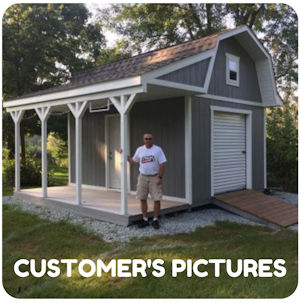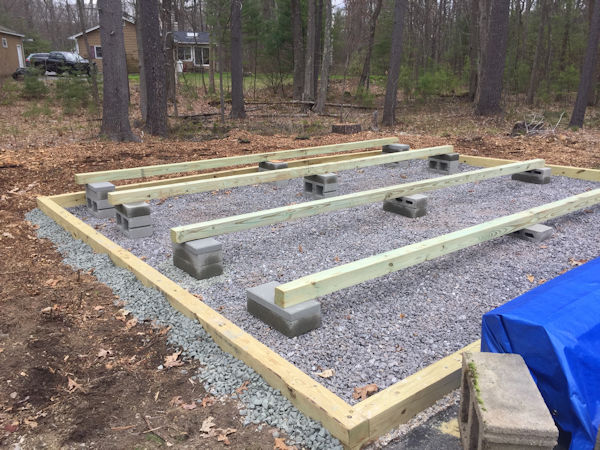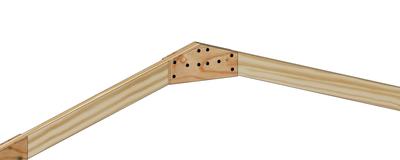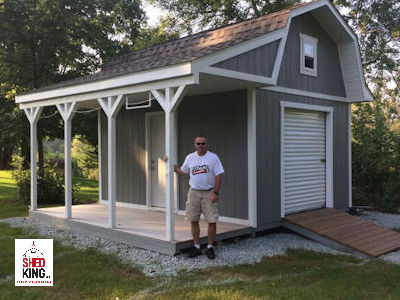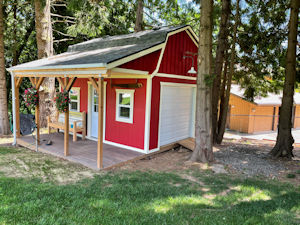Want to Save 30% off Any Shed Plan Purchase!
Signup For My 'Shed n Sight' Newsletter
and Get Your 30% off Promo Code To Use At Checkout.
- Home
- Proper Shed Building Tips
- Cost to insulate your shed
How much does it cost to insulate a shed in 2024?
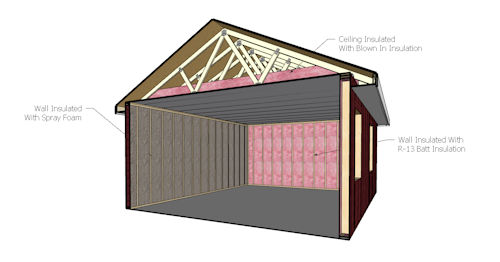 Some Examples of Shed Insulation
Some Examples of Shed InsulationThe cost to insulate a shed depends on numerous factors such as the type of insulation, the size of the shed, labor costs if you hire professionals and even the specific part of the shed you are insulating – the walls, ceiling, or floor. It might sound complex, but by the end of our conversation, you'll have a better understanding of these variables.
Why Should You Insulate Your Shed?
Before diving into costs, your question might be – is it really necessary to insulate a shed? Well, the answer depends on what you'll be using it for. If you plan to use your shed as a storage space for garden equipment or simple tools, insulation might not seem essential. But if your shed is more than just a storage space or garden shed, say, a home office, a workshop, or even a cozy retreat, then insulation is vital to ensure comfort and energy efficiency, particularly during extreme temperatures.
Insulating your shed helps in maintaining a stable temperature inside by reducing heat loss during winter and preventing heat gain during summer. It prevents moisture build-up, which could lead to water damage, and also reduces noise. A well-insulated shed can even save you considerable energy costs in the long run if you're using heating or cooling devices inside.
Understanding the Variables of Insulation Cost
Now let's jump into the meat of the matter – the actual costs of insulating a shed. The insulation material cost is usually calculated per square foot. The particular type of insulation makes a significant impact on the overall cost, and there are plenty of types to choose from.
The Popular Choices: Types of Insulation and Their Costs
One of the most common types of insulation to use in a shed is fiberglass batts.
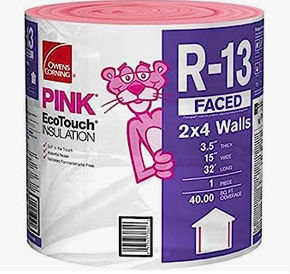 Batt Insulation and Roll Insulation Typically Used To Insulate Walls
Batt Insulation and Roll Insulation Typically Used To Insulate WallsThis type of insulation is a good option as it is relatively inexpensive and easy to install yourself, making it a great way for DIY enthusiasts to save on labor costs. Fiberglass batts cost between $0.30 and $0.60 per square foot, but remember to wear long sleeves while handling it as small particles of fiberglass can cause skin irritation.
Walls framed 16" on center with 2x4's typically would be insulated with R-13 faced insulation. If your walls are framed with 2x6's you could go with R-19 faced insulation.
Another popular option is rigid foam board insulation, which comes in large sheets that can be cut to size. Offering a high R-value (measure of thermal resistance), this type of insulation is also resistant to moisture. The cost of foam board insulation varies depending on thickness and R-value but typically ranges from $0.50 to $1.50 per square foot.
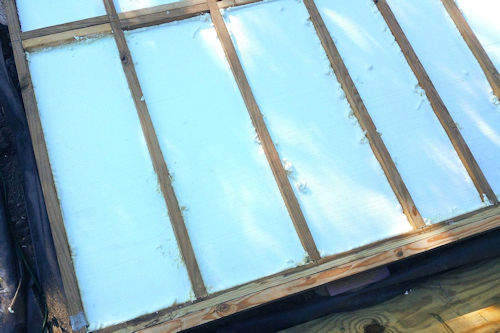 Rigid Foam Board Used To Insulate A Shed Floor
Rigid Foam Board Used To Insulate A Shed Floor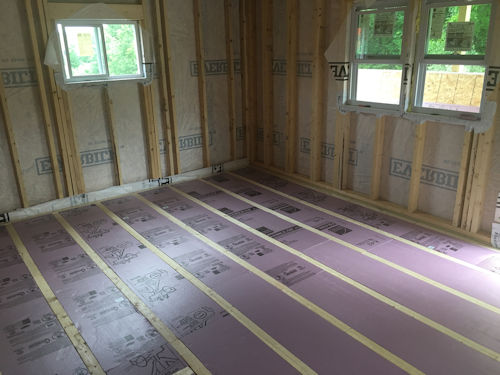 Another Shed Using Rigid Foam Board
Another Shed Using Rigid Foam BoardBlown-in insulation is another excellent choice for shed insulation. This is a method where a machine blows loose-fill insulation into the shed's wall cavities or attic. It’s a good idea to hire a professional to take this on, as it involves special machinery. The material costs for blown-in insulation fall between $0.80 and $1.00 per square foot. But considering the labor costs, expect to shell out between $1.50 and $2.50 per square foot.
One option that provides a superior level of insulation– spray foam insulation. There are two types: open-cell spray foam (less expensive, less insulating) and closed-cell spray foam (more costly, more insulating). Spray foam insulation is one of the most efficient but also the priciest, with costs potentially reaching up to $3.00 per square foot for the material alone, and labor costs will add significantly to this.
For the budget-conscious homeowners, there’s also the option of using bubble wrap, plastic sheeting, or breathable membrane – these are the cheapest options and may cost as low as $0.10 per square foot. However, keep in mind they offer much less insulation than other types.
The Labor Aspect: DIY vs Hiring Professionals for Insulation
Now, regarding labor costs, if you're a fan of DIY, you've got this covered without an additional penny! But if you stand on the "better-safe-than-sorry" side, hiring a professional wouldn't be a bad idea, especially when dealing with tricky insulation types like spray foam or blown-in insulation. The additional cost of an insulation contractor can range anywhere from $0.20 to $1.00 per square foot based on your locale and the complexity of the job.
Additional Expenditure: Accessories Needed for Insulation
Beyond the material and labor costs, you'll also need to consider the costs of accessories such as a vapor barrier or a moisture barrier, adhesives, and fasteners needed in the process. Although these are minor costs, they still significantly influence the total project cost.
One example is if you decide to insulate your shed walls with unfaced batt insulation, you would want to add a moisture barrier by stapling plastic sheeting over the insulation.
Cost Considerations Based on Shed Size and Design
The shed size inevitably impacts the total cost of insulation. Simply put, larger sheds require more insulation, thus increasing costs. Also, the cost may vary based on whether you want to insulate the floor, the walls, or the ceiling/roof of your shed. If you build your shed walls with 2x6's as opposed to building it with 2x4's, the deeper wall cavity will require thicker insulation which will cost more.
Insulating the ceiling or roof can often prove quite challenging and might require professional help, consequently increasing the cost.
Updated building codes in your area may require insulating your shed ceiling with a minimum R-30 insulation. This may be all but impossible to do if you are insulating a barn style roof where you may be inhabiting the upper loft with say a bedroom.
Your Shed Material and Impact on Insulation Cost
Sheds made from different materials behave differently when it comes to insulation. A metal shed, for example, can quickly turn into ovens during summer and freezers during winter without proper insulation.
If you have a wooden shed or even a plastic shed, insulation is crucial not just for thermal regulation but also to avoid condensation buildup which can lead to serious damage. Each shed type may affect the total cost to insulate due to different installation needs.
Location Impact on Shed Insulation Type and Cost
The physical location of your shed could pose some challenges too. If positioned under trees or a shady area, you might get away with less insulation. But if it’s out in open land where winds have a clear run at it, you will need thorough insulation.
If your location experiences extreme temperatures or weather conditions, you’d need to give special attention to selecting high R-value insulation materials, increasing costs.
Your Insulation Investment: Breaking down the Total Cost of Shed Insulation
So, by adding up the material costs, labor (if any), and additional materials you may need to install or purchase, you can calculate how much it will generally cost to insulate your shed. It could be anywhere between $1.00 per square foot on the lowest end (doing everything yourself using the least expensive materials) to $3.00 or perhaps even as high as $4.00 per square foot on the higher end (using premium materials and hiring professionals).
Gearing Up for the Insulation Project: Key Deciding Factors
The final decision on how to insulate a shed will depend on factors like the purpose of your shed, the type of shed you have, the local climate, and of course, your budget. Remember, insulation is a long-term investment, and while it might seem costly initially, it might save you on energy bills in the long run, especially if you’re using the shed as a living space or home office.
What can happen if you don't insulate your shed properly?
If you don't insulate your shed walls and ceiling properly, a number of issues can arise:
1. Temperature Fluctuations: Without proper insulation, your shed can become very hot during the summer months and freezing cold in the winter. This can make the shed uncomfortable and even potentially dangerous for use, depending on what you're storing inside.
2. Condensation and Mold: Inadequate insulation can lead to condensation on the inside of the shed, fostering the growth of mold and mildew. This can damage items stored in the shed, and can also lead to health issues for people spending time in the shed.
3. Energy Inefficiency: If you're using heating or cooling devices inside the shed, they will have to work harder to maintain a stable temperature, leading to higher energy consumption and increased utility bills.
4. Damage to Building Materials: Extreme temperature fluctuations and increased moisture can speed up the deterioration of the shed's materials, reducing its lifespan.
5. Noise Pollution: Without appropriate insulation, the shed will do little to dampen outside noise, resulting in a less peaceful and more disruptive environment.
Therefore, it is essential to invest time and resources in proper insulation to ensure that your shed is comfortable, energy efficient and durable.
Finishing Thoughts: The Worthwhile Effort for Insulating Your Shed
To wrap up, insulating your shed isn't just about throwing in some insulation and hoping for the best. It's ideally about understanding what your shed needs based on its purpose, the climate, and material costs, along with labor costs if you're planning to hire a professional.
Relevant Resources for Shed Insulation
Remember, there's no one-size-fits-all answer for how much it might cost you to insulate your shed. The "best way" for you will largely depend on your specific circumstances and needs. And this guide, I hope, gives you a better idea of where to start. So, don’t hesitate. Gauge your needs, start planning, gather your materials, and transition your bare shed into a well-insulated, functional space. It’s definitely worth the effort!
After insulating your shed, what about heating it?
I've got a whole bunch of information on how to heat your shed. Check it out here.
Monthly DIY
Shed-in-sight
Newsletter
Subscribing will get you discounts on shed plans, monthly updates, new shed design ideas, tips, exclusive discounts on shed building resources and tools. Learn more here.
Recent Articles
-
Does Your Shed Need Shed Floor Skids?
Feb 12, 25 05:53 AM
Shed floor skids will help support your shed floor. They will also allow you to anchor your shed floor to the ground using concrete piers. See how here. -
Gusset fasteners
Feb 06, 25 06:31 AM
For fastening gussets to shed trusses, is it best to use nails or bolts? -
Easy Diy Shed Plans and Ideas For You To Build Sheds
Dec 31, 24 09:49 PM
All types of shed plans for gable, barn, saltbox, and lean to style sheds small and large that can be used for storage, shed to house, workshops and more.
My You Tube Videos


